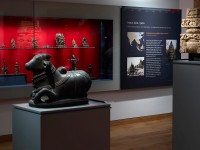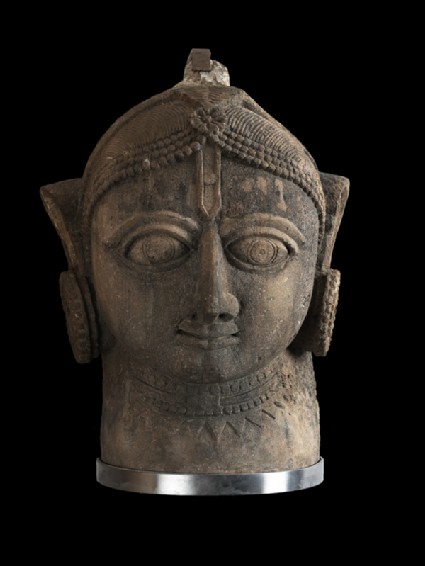Room 32 | India 600-1900 gallery
Explore Hindu, Buddhist and Jain art from India, the Himalayas and Southeast Asia.

Galleries : 299 objects
- Reference URL
Actions
Head of a yogini or goddess
-
Details
- Associated place
-
Asia › India › west India › Gujarat (possible place of creation)Asia › India › west India › Rajasthan (possible place of creation)
- Date
- 2nd half of the 17th century - 1st half of the 18th century
- Material and technique
- grey sandstone
- Dimensions
- 44 x 34 x 23 cm max. (height x width x depth)
- Material index
- Technique index
- Object type index
- No. of items
- 1
- Credit line
- Purchased, 1965.
- Accession no.
- EA1965.41
-
Further reading
Harle, J. C., and Andrew Topsfield, Indian Art in the Ashmolean Museum (Oxford: Ashmolean Museum, 1987), no. 60 on pp. 49-50, illus. p. 50
Location
Objects are sometimes moved to a different location. Our object location data is usually updated on a monthly basis. Contact the Jameel Study Centre if you are planning to visit the museum to see a particular object on display, or would like to arrange an appointment to see an object in our reserve collections.
Publications online
-

Indian Art in the Ashmolean Museum
In Indian art, most detached heads sculptured in stone have been broken off their bodies, as in the case of [EA1963.27, EA1961.138, EAOS.61, and EAX.245]. In Rajasthan or Gujarat, however, heads such as this one replaced the tip of the central spine of each of the four sides of the śikhara (“tower”) of the “northern” types shrines built at a relatively late date. They are called yoginīmukhas (yoginī heads) and presumably represent one of the minor female deities or demonesses who follow Durgā. In certain other parts of India, lions or other figures occupy this position.
The style or approximations to it is most often seen in small brass heads from the same regions of western India and, except for folk art (there are traces of folk style here), represents the final purely Indian stylistic development there before the admixture of European elements.
Galleries
Notice
Objects may have since been removed or replaced from a gallery. Click into an individual object record to confirm whether or not an object is currently on display. Our object location data is usually updated on a monthly basis, so contact the Jameel Study Centre if you are planning to visit the museum to see a particular Eastern Art object.
© 2013 University of Oxford - Ashmolean Museum




